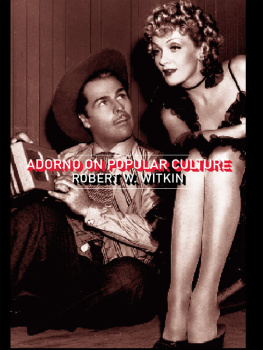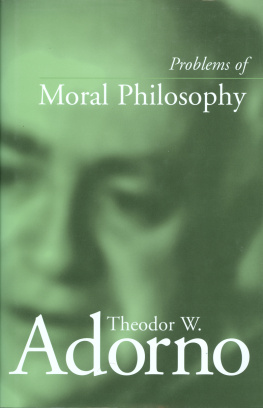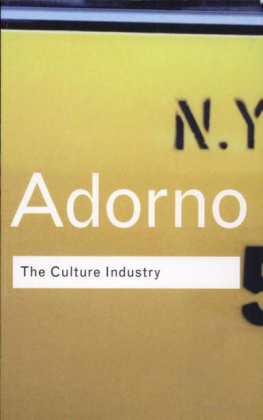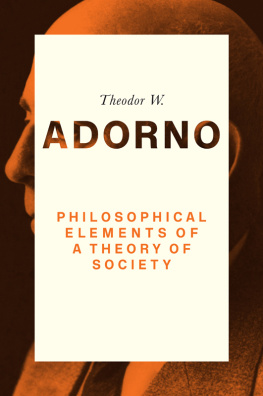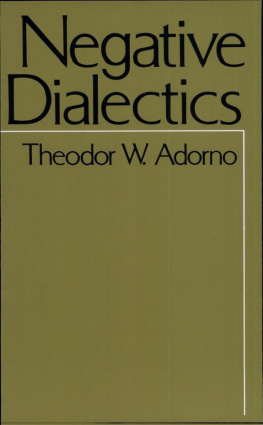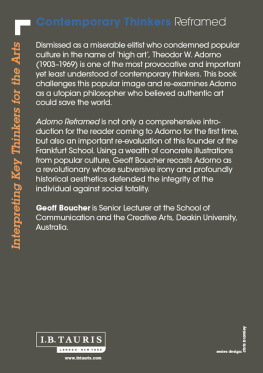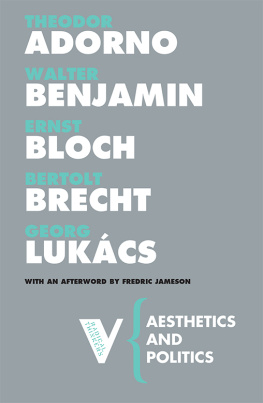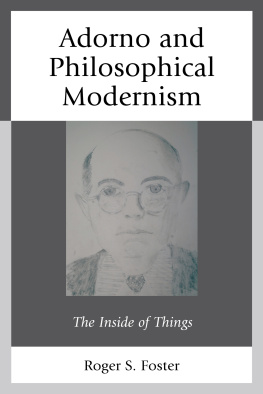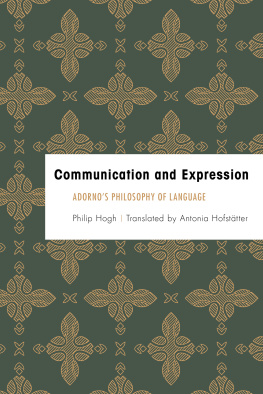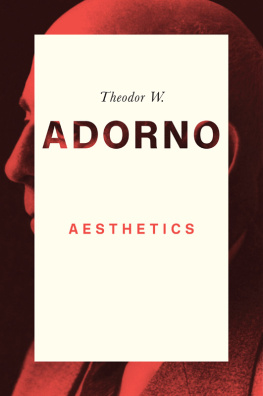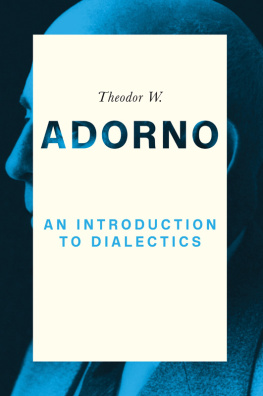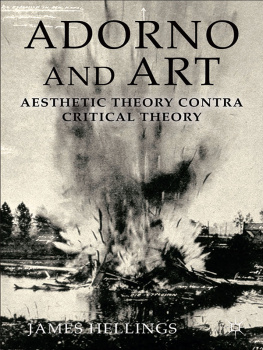
Copyright page
First published in German as sthetik (1958/59), Suhrkamp Verlag, Frankfurt am Main, 2009
This English edition Polity Press, 2018
The translation of this work was funded by Geisteswissenschaften International Translation Funding for Humanities and Social Sciences from Germany, a joint initiative of the Fritz Thyssen Foundation, the German Federal Foreign Office, the collecting society VG WORT and the Brsenverein des Deutschen Buchhandels (German Publishers & Booksellers Association).
Polity Press
65 Bridge Street
Cambridge CB2 1UR, UK
Polity Press
101 Station Landing
Suite 300
Medford, MA 02155, USA
All rights reserved. Except for the quotation of short passages for the purpose of criticism and review, no part of this publication may be reproduced, stored in a retrieval system or transmitted, in any form or by any means, electronic, mechanical, photocopying, recording or otherwise, without the prior permission of the publisher.
ISBN-13: 978-0-7456-7939-6
ISBN-13: 978-0-7456-7940-2 (pb)
A catalogue record for this book is available from the British Library.
Typeset in 10.5 on 12 pt Sabon
by Toppan Best-set Premedia Limited
Printed and bound in Great Britain by CPI Group (UK) Ltd, Croydon.
The publisher has used its best endeavours to ensure that the URLs for external websites referred to in this book are correct and active at the time of going to press. However, the publisher has no responsibility for the websites and can make no guarantee that a site will remain live or that the content is or will remain appropriate.
Every effort has been made to trace all copyright holders, but if any have been inadvertently overlooked the publisher will be pleased to include any necessary credits in any subsequent reprint or edition.
For further information on Polity, visit our website: politybooks.com
Editor's Foreword
Adorno had been planning for some time to write a systematic book on aesthetics; his notes and drafts go back to at least 1956. A decisive factor in the genesis of the book, which was meant to become his central work, were the lectures on this subject that he gave a total of six times between 1950 and 1968.
The present course of lectures from the winter semester of 1958/59 is the fourth in this series. It is also the earliest to be documented in full by transcripts made from tape recordings at the Institute of Social Research. As the editorial traces in the typescript show, Adorno worked further on this text while preparing later lectures, and also while working on what would later become the Aesthetic Theory.
We have little information about Adorno's first aesthetics course after his return from American exile, except for the fact that it took place in the summer semester of 1950 on Mondays, Tuesdays and Wednesdays from 4 to 5 pm. As for the second course, from the winter semester of 1950/51, the Theodor W. Adorno Archive contains typewritten elaborations on key points, as well as a summary that indicates the range of topics discussed and a number of central theses. The third course, from the winter semester of 1955/56, is documented by handwritten drafts and notes, as well as a transcript elaborated from stenographic notes. Alongside the present fourth course, there exists also a complete tape transcript of the fifth, which Adorno gave in two parts in the summer semester of 1961 and the winter semester of 1961/62. The final course, also spread across two semesters the summer 1967 and winter 1967/68 semesters was given when large parts of the Aesthetic Theory had already been written and survives only in various drafts, notes, stenographic notes and partial tape transcripts. Excerpts from tape transcripts of a few lectures from the second semester were published in 1973 in an unauthorized edition that fell severely short of academic standards. The editor of this pirate edition, who signed his preface merely with the initials C. K., states that the quality of the tape recordings was extremely poor.
The course of lectures from the winter semester of 1958/59 is instructive in several respects. It is a document of its time, intertwined in many ways with the artistic, intellectual and political confrontations that shaped life in West Germany during the Cold War. It documents a form of academic teaching that would be inconceivable in the framework of current BA or MA programmes. The unity of research and teaching, which, at the time it was practised, never required a word of commentary or discussion, can be reconstructively observed in these lectures at a distance of half a century. It did not consist merely in the professor presenting those elements of their research findings which they considered relevant; for Adorno, the course itself was a kind of laboratory in which he first developed his ideas, or could at least due to the necessity of making himself understood give them a structure and vividness that first had to be wrested from the complexity of the specific issues interwoven within them. The productivity of this gradual formulation of thoughts while speaking, as Kleist put it, becomes especially clear if one examines the relationship between the recorded sessions and the notes with which Adorno prepared his lectures, as well as the published texts to which he refers, and if one observes how Adorno himself went through the transcripts of his unscripted words, marking passages that struck him as particularly incisive.
Various topics that would later be elaborated in the Aesthetic Theory are mentioned, some of them developed in greater detail; fundamental motifs were already clear to Adorno, but some evidently reached a clear formulation only through the lectures themselves. At various points, the lectures go beyond what would later be taken up into the Aesthetic Theory. This applies not only to his engagement with Georg Lukcs, which became a stronger focus during the autumn and winter of 1958/59 than he considered necessary while editing the texts intended for the Aesthetic Theory. One should especially emphasize Adorno's reflections on the theory of aesthetic experience, which are probably even more relevant now with respect to certain developments in philosophical aesthetics since the 1970s. Another notable aspect is Adorno's intensive engagement with the classical interpretation of beauty in Plato's Phaedrus, as well as the great interest he showed during the autumn of 1958 in the experiments of John Cage, which he evidently found somewhat confusing but deeply challenging and would later increasingly view as a questionable invitation to regression and ego weakness.
This edition is based on 246 pages of tape transcripts preserved in the Theodor W. Adorno Archive under the numbers Vo 34973742. Marginal notes and other editing traces on the typescript attributable to Adorno are mentioned in the notes. While editing, care was taken to preserve the character of unscripted speech as well as Adorno's stylistic, lexical and syntactical idiosyncrasies. Obvious transcription errors were corrected as far as the content dictated. In a few cases, and only when there was no nuance of meaning involved, repetitions and phrase markers such as and, so and now, as well as gap-fillers such as actually or if you like, were removed. Occasionally, for the sake of readability, run-on sentences meandering via various associations had to be separated into two or more sentences. The punctuation, which had to be inserted by the editor, served primarily to make the structure of the sentences as clear as possible despite their occasional interruptions by passing thoughts. Gaps in the text owing to changes of tape or technical problems are marked with [] and mentioned in the notes. Occasional omissions from texts quoted by Adorno are likewise marked with []. Additions to the text by the editor are indicated by square brackets. The notes are intended essentially as explanations of names, works and events mentioned in the lectures, as well as concepts which can perhaps no longer be taken as understood. In cases where a complex issue is touched on only in passing, or where Adorno's meaning does not become clear, references are given to correspondences in his published writings.
Next page

